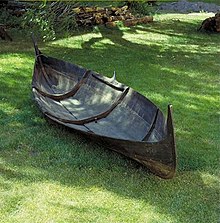Boat grave at Årby Gård
The boat grave at Årby Gård ( Swedish Årbybåten ) contained a boat that is so far the only one of its kind. It was found at Årby Gård, near Rasbokil, east of Uppsala in eastern Sweden in 1933 and excavated in 1935.
The boat, which dates from the early 10th century, is 3.95 m long and 1.05 m wide. The weight of the boat, which is not a dugout canoe but consists of five riveted planks, was about 55 kg. It could carry a load of around 130 kg. That means it could carry a human plus a load or two in calm waters over long distances. It had oars and paddles with a movable row bank. Repairs and other references show that the boat had been in use for more than 100 years before it was used to bury a woman.
The boat has an interesting place in maritime archaeological history because its shape and structure indicate the influence of a non-local ethnic group , the Sami . Little is known of how the hunting groups that started around 1000 BC. Before the Viking Age (800–1050 AD) , they dealt with domesticated reindeer , to which the Sami are related. Around 500 AD, however, the northern Swedish groups came into contact with the Vendel period people , and knowledge was also exchanged. In this context, the boat was built in the 9th century and ended a hundred years later in the boat grave at Årby Gård. The burial custom, which began with the boat graves of the Vendel period (550–800 AD), did not end until the end of the Viking Age (1050 AD).
The boat is now in the collection of the State Historical Museum in Stockholm.
literature
- Holger Arbman : Årby. In: Reallexikon der Germanischen Altertumskunde (RGA). 2nd Edition. Volume 1, Walter de Gruyter, Berlin / New York 1973, ISBN 3-11-004489-7 , pp. 390-391.
- Holger Arbman : Båtgrav vid Årby Gård i Rasbokil socken, Uppland. In: Fornvännen. 31, 1936, pp. 249-251 .
- Holger Arbman: The Årby Fund. In: Acta Archaeologica. 11, 1940, ISSN 0065-101X , pp. 43-102.
- Carl Olof Cederlund (Ed.): The Årby boat (= The Museum of National Antiquities, Stockholm. Monographs. 2). Statens Historiska Museum ua, Stockholm 1993, ISBN 91-87360-07-1 .
- Mårten Stenberger : Nordic prehistory. Volume 4: Prehistory of Sweden. Wachholtz, Neumünster 1977, ISBN 3-529-01805-8 .
Web links
- Årby Gård's boat grave - entry in the "Fornsök" database of Riksantikvarieämbetet (Swedish)
- Conservation report Årbybåten
Coordinates: 59 ° 59 ′ 43.2 ″ N , 17 ° 51 ′ 2.4 ″ E
